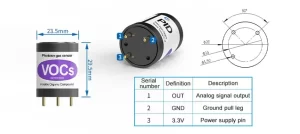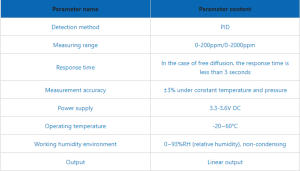-
Enhancing Safety Measures: Gas Detection Devices for Improved Workplace Security
- Introduction: Ensuring workplace safety is of paramount importance in any industry. One critical aspect of workplace security is the detection and monitoring of hazardous gases. Gas detection devices play a vital role in safeguarding work……
- Chat Online
-
Description
Introduction: Ensuring workplace safety is of paramount importance in any industry. One critical aspect of workplace security is the detection and monitoring of hazardous gases. Gas detection devices play a vital role in safeguarding workers and preventing accidents or health hazards caused by the presence of harmful gases. This article will explore the significance of gas detection devices, their types, working principles, and the benefits they bring to workplace safety.

I. The Significance of Gas Detection Devices:
A. Identifying Hazardous Gases: Gas detection devices are designed to identify the presence of various hazardous gases, including combustible gases, toxic gases, and oxygen deficiency or enrichment. Early detection allows for timely response and the implementation of appropriate safety measures.
B. Ensuring Worker Safety:
By providing real-time monitoring and alerts, gas detection devices help protect workers from potential gas-related risks, such as explosions, fire, suffocation, or long-term health effects.
C. Compliance with Regulatory Standards:
Many industries are subject to regulatory requirements for gas detection. Compliance with these standards is crucial for maintaining a safe working environment and avoiding legal repercussions.
II. Types of Gas Detection Devices:
A. Fixed Gas Detectors: Installed in specific locations, fixed gas detectors continuously monitor gas levels in confined spaces or areas prone to gas leaks. They are typically hardwired into the building's infrastructure for consistent monitoring.
B. Portable Gas Detectors:
These handheld devices provide flexibility and mobility for workers to monitor gas levels in different areas of the workplace, allowing for immediate response and evacuation if necessary.
C. Area Gas Monitors:
Area gas monitors are designed to detect gases in larger spaces or open areas. They provide broad coverage and can be used for continuous monitoring in warehouses, manufacturing plants, or outdoor work sites.
III. Working Principles of Gas Detection Devices:
A. Catalytic Sensors: Catalytic sensors detect combustible gases by measuring the heat generated during gas oxidation. They are widely used for detecting flammable gases like methane and propane.
B. Electrochemical Sensors:
Electrochemical sensors detect toxic gases by measuring the electrical current produced when the target gas interacts with an electrode. These sensors are commonly used for detecting gases like carbon monoxide, hydrogen sulfide, and chlorine.
C. Infrared Sensors:
Infrared sensors detect gases by analyzing the absorption of infrared radiation. They can identify various gases, including hydrocarbons, carbon dioxide, and methane.
D. Semiconductor Sensors:
Semiconductor sensors detect gases by measuring changes in electrical resistance caused by gas interactions with a semiconductor material. They are commonly used to detect combustible gases.
IV. Benefits of Gas Detection Devices:
A. Early Warning Systems: Gas detection devices provide early warning of gas leaks or hazardous levels, allowing for prompt evacuation and the initiation of safety protocols, such as shutting down equipment or ventilation systems.
B. Real-Time Monitoring:
Continuous monitoring of gas levels ensures that any changes or anomalies are detected immediately, reducing the risk of accidents and health hazards.
C. Data Logging and Analysis:
Many modern gas detection devices are equipped with data logging capabilities, allowing for the collection and analysis of historical gas level data. This data can help identify trends, patterns, or potential areas of concern.
D. Remote Monitoring:
Some advanced gas detection devices offer remote monitoring capabilities, enabling real-time alerts and notifications to be sent to designated personnel via mobile devices or centralized control systems.
V. Maintenance and Calibration:
A. Regular Maintenance: Gas detection devices require periodic maintenance to ensure their proper functioning. This includes sensor cleaning, filter replacement, battery checks, and overall system calibration.

B. Calibration:
Calibration is crucial to maintain accuracy and reliability. Gas detection devices should be calibrated according to manufacturer guidelines and industry standards to ensure accurate gas level readings.
Conclusion:
Gas detection devices are indispensable tools for enhancing workplace safety and security. By detecting and monitoring the presence of hazardous gases, these devices play a critical role in preventing accidents, protecting workers, and ensuring compliance with regulatory standards. Employing gas detection devices not only mitigates potential risks but also contributes to a safer working environment and the overall well-being of employees.
-
Recommend:
-
-
Enhancing Safety Measures: Gas Detection Devices for Improved Workplace Security
Introduction: Ensuring workplace safety is of paramount imp…
-
Gas detectors are essential devices used to detect and moni…
-
Gas sensors are electronic devices that detect, measure, an…
-
Gas detectors are essential safety tools that detect the pr…
-
 : +86 155 8830 2704
: +86 155 8830 2704 : jxdziot@gmail.com
: jxdziot@gmail.com
